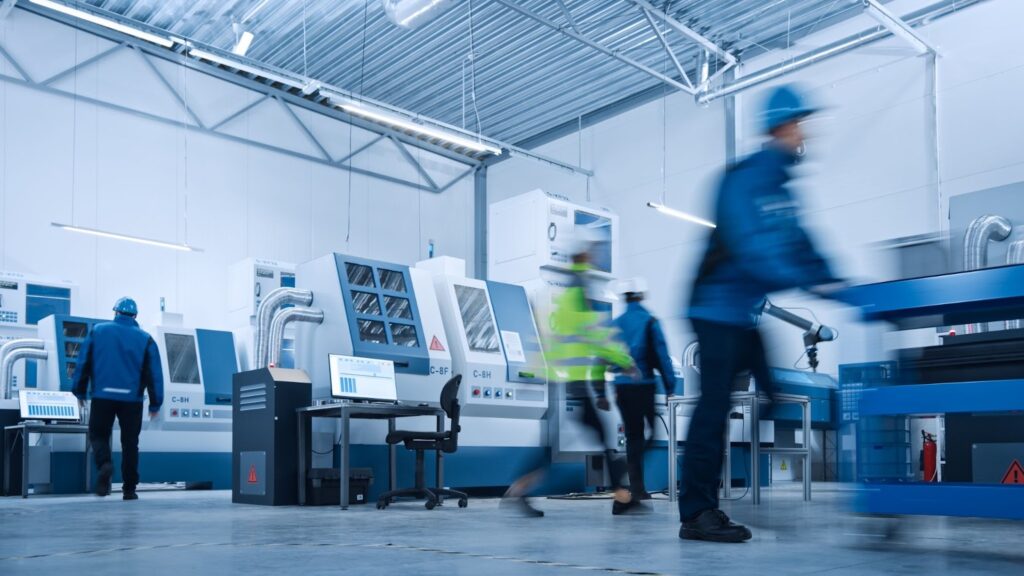In our previous article, we explained the Internet of Things. One of the branches of IoT is the Industrial Internet of Things, and we’ll talk more about this concept in the following blog.
While IoT and IIoT have many technologies in common, including sensors, connectivity, machine-to-machine communications, data analytics, and cloud platforms, their purpose is somewhat different. The Internet of Things is designed to make our lives easier and work more manageable. Industrial IoT does the same but in the business context.
IoT can be applied to multiple verticals and government and cities, and IoT devices are primarily user-centric. In the industrial context, there is a greater level of complexity, so it’s important to proactively predict and solve critical situations. IIoT connects devices, clouds, analytics, and people to optimize the execution and productivity of industrial processes while improving overall efficiency and safety.
Similar to IoT, IIoT is also based on a network of connected smart devices for monitoring, collecting, exchanging, and analyzing data. The full potential of the IIoT can only be leveraged when disparate systems are brought together in an interconnected platform.
IIoT architecture
An IIoT ecosystem is similar to the general IoT architecture, as it also consists of interconnected smart devices for monitoring, collecting, exchanging, and analyzing data.
Simply put, typical IIoT architecture consists of:
- smart devices and machines that can sense, communicate and store data
- gathering, filtering, and preprocessing data from multiple sources in an aggregation system, like Edge Gateway (not always necessary, for example, with Sensolus, there are no gateways)
- cloud computer systems to store and process the data
- advanced data analytics systems that provide helpful information to improve manufacturing processes and employees who put given insights into a business context
At Sensolus, we take a step further in simplifying the infrastructure. Our solution is based on a plug-and-play principle that provides a unified environment with trackers & sensors, smart processing, an Edge-Cloud combination, and an IoT software platform to monitor, analyze, and translate the data provided into valuable business insights.
IIoT business cases
Looking at the above-mentioned benefits of IIoT, it’s clear why businesses should invest in implementing IIoT into their operations. The next question is what type of businesses could benefit the most from this ecosystem?
IIoT is already used across several industries, mostly in manufacturing (currently the largest IIoT market), logistics, energy, and utilities. According to Forbes, global spending on IIoT platforms for manufacturing is predicted to grow from $1.67B in 2018 to $12.44B in 2024, attaining a 40% compound annual growth rate in seven years.
Here are just a few other industries where IIoT can be applied:
- Aerospace (airports, airplanes, drones, and other unmanned air vehicles)
- Agriculture (connected farms, livestock, machines, vehicles)
- Automotive (connected, semi-autonomous, and autonomous vehicles)
- Energy Systems (smart grid, energy resources, and renewable energy)
- Healthcare (connected healthcare, robotic surgery, and medical imaging)
- Military (military vehicles, simulations, training, and operations)
- Smart Cities (citizen and municipal services, parking, and infrastructure)
- Transportation and logistics (buses, subways, trains, and hyperloop)
How IIoT drives business value and creates new opportunities
For a manufacturer looking for a competitive advantage, IIoT offers many opportunities. It can help you modernize the entire workflow, from maintenance and supplier logistics to employee workflows and product delivery. It streamlines and automates, leading to increased productivity, more efficient operations, cost savings, and elevated revenue opportunities.
With IIoT, businesses become data-driven and focused on achieving overall better performance and results. For many businesses, implementation of IIoT comes with many perks like:
- Increased efficiency
The biggest benefit of IIoT is that it gives manufacturers the ability to automate and optimize their workflows. Robotics and automated machinery work more efficiently and accurately, helping manufacturers streamline end-to-end operations.
- Real-time visibility through asset tracking
Asset tracking monitors crucial data and information on the status, condition, and location of assets. Through the asset tracking software, organizations can improve asset utilization, visibility, planning, and maintenance.
- Predictive maintenance
According to Analyst firm Aberdeen Research, 82% of companies have experienced unplanned downtime over the past three years following high costs of as much as $260,000 an hour. Thanks to the IIoT’s predictive maintenance ability, businesses can make an intervention before the damage is done.
- Optimal planning and inventory management
Today global supply chains are struggling to meet customer demand and ever-growing competition. One of the solutions is inventory optimization. Businesses can monitor the location of the assets, their condition, and other factors through sensors, decreasing costs, manual work, and preventing damages. Knowing exact and real-time data on assets means decreasing costs, manual work, and preventing damages.
- Save time and reduce costs
Data-driven insights rely heavily on IIoT to bring value, optimize operations, create new products or services, and design better business models.
Closing thoughts
We must look at IIoT from different perspectives to understand its true value. For some businesses, it’s crucial to have a fully integrated view of operations. Others focus on data integration and extracting business insights to grow and gain a competitive advantage. And others go even further, developing new IIoT business models.
If you want to know more about IIoT, reach out to our team, and we’ll answer your questions!
